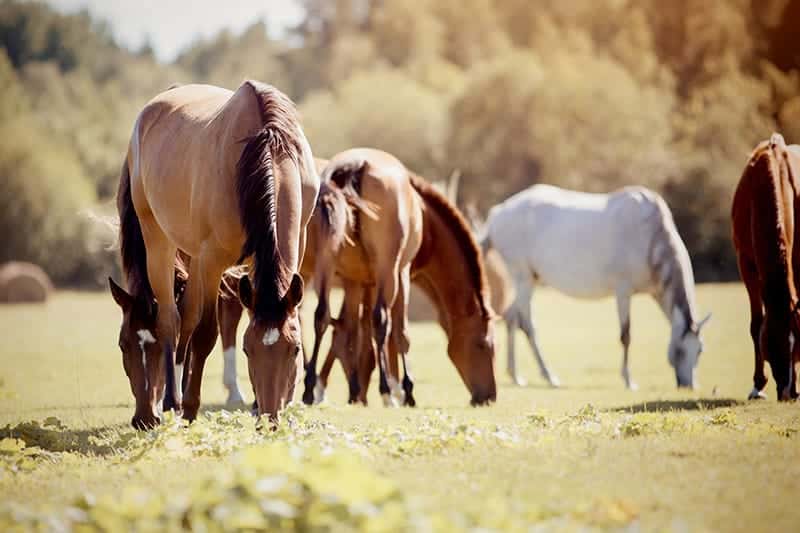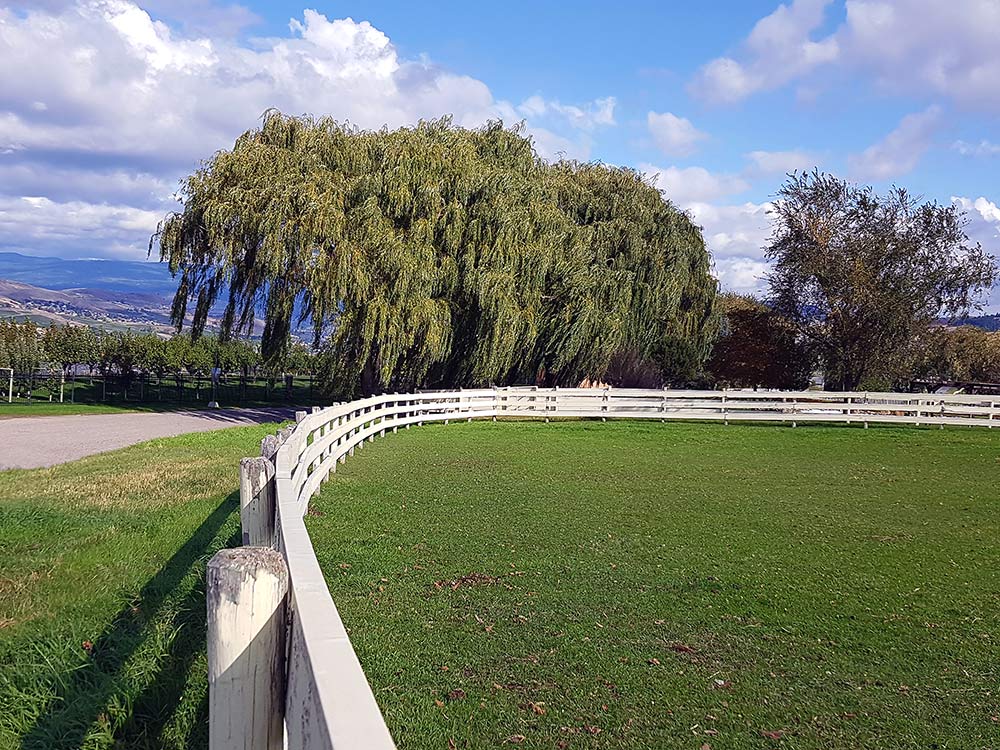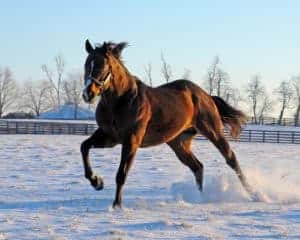Introducing a New Horse to the Herd
Learn steps to safely and successfully add a new horse to an existing herd

We envision our horses living peacefully in wide open rolling pastures, in herds of happy equids that graze together and groom each other’s withers, just like nature intended.
It’s an idyllic image, and equine behaviorists say it’s a fantastic—and realistic—goal. But in practice, when managing herds of sport and leisure horses, it’s not always possible. Some horses suffer the consequences of unfriendly or hostile herdmates—especially when they’re the new kid on the block.
So how do you safely integrate a new horse into an established herd? To accurately answer that question and bring you helpful, reliable advice, we have gone to worldwide experts who speak to the latest scientific knowledge as well as their own real-world experiences.
‘It So Often Goes Wrong’—Introducing New Horses
The fact is horses—like people—don’t always get along with each other at first, says Paula Hitzler, BSc in animal science, farm manager of the Michigan State University Horse Teaching and Research Center (MSUHTRC), in Lansing.
People often add new horses into a pasture with other horses with little to no supervision, expecting them to be compatible. And that, Hitzler says, is the No. 1 mistake they make.
Kate Fenner, PhD, of the University of Sydney, in Australia, agrees.

“It so often goes wrong,” Fenner says. “People get a new horse, and they throw him into the paddock with the others, and suddenly he’s all beaten up. What we want to really avoid is throwing them out in the paddock and letting them work it out
themselves because, quite often, they don’t do a great job of that.”
Well-planned transitions are a better solution, says Laura Torres Borda, PhD candidate in the Equine Surgery Unit of the University of Veterinary Medicine Vienna’s Department of Companion Animals and Horses, in Austria.
“By thoughtfully introducing new horses, we can minimize these risks and promote smoother integration within the herd, fostering a healthier environment for all group members,” Torres Borda says.
Quarantine for Horses, Homework for You
When buying a new horse, a critical “homework assignment” for new owners is learning about that horse’s social history, Fenner says. If the horse has spent many years stalled and pastured alone, he probably lacks equine social skills—making it harder to integrate into a new herd.
Humans can’t teach this horse-specific social language, Hitzler adds. But without it, your new horse will not understand what other horses are telling him, she says. He’ll need extra time and a gentle horse buddy (more on this in a moment) to teach him the ropes before joining the whole herd.
Dr. Laura Torres Borda
Once home, be sure to quarantine your new horse for 15 days to ensure he’s not harboring any transmissible pathogens, Fenner says. This is also a great time for him to get used to his new surroundings—which often takes longer than the quarantine period.
Meanwhile, get to know your new horse and take a fresh look at your current herd, she says. This will ensure you know each horse’s personality and the current herd dynamics and establish a helpful baseline for evaluating how the integration is going.
Good Fences Make Good ‘Neigh’-bors
Horse introductions always start with a great fence, our sources say. After the initial quarantine period the new horse should stay alone on one side, while the rest of the herd lives on the other.
At first, use a fence that puts space between the horses, Fenner says. You can use spacer devices, sometimes called standoffs, to hold an electrified line toward the inside of each field. Otherwise, you can space two fences slightly apart to create a sort of “no man’s land” between the barriers. The point is to allow the horses to touch noses but not forelimbs.

A temporary electric fence, placed on either side and about a meter from the main fence, will minimize contact and also stop your horses from getting their feet caught in a wire fence, should one of them strike out at their new neighbor.
Fenner says this allows horses to “get all that striking and vocalizing and that sort of thing over with” while avoiding injury. The fence should be high enough that if horses strike out—as they often do when meeting new horses—their feet won’t get caught in the fence. “That can be really dangerous,” she says.
When everyone appears settled—usually after a few days—switch to a simpler fence, such as a basic two-strand electric fence, which allows for closer contact, she says.
As always, avoid any fence that could cause injuries—especially those with sharp edges like splintered wood or barbed wire.
The ‘Bus Seat Buddy’ and Other Gradual Friendships
Once the herd and new horse have settled on their separate sides of the simple fence, it’s time to find a buddy for the new horse.
Much like people, horses blend better into a group if they can bond with just one or two individuals first. “It’s kind of like when you send your kid to school, and it’s really nice if they meet one or two other kids on the bus before they get there,” Hitzler says. “It seems to help them integrate better when they already have a friend.”
This is usually “much less overwhelming than putting them in together with the
others right away,” Fenner says.
Still, success depends highly on your choice of “bus seat buddy.” For Fenner, it should be “the quietest, most congenial horse” you have in your herd. “That’s the one who seems to get on with everyone and doesn’t really give a hoot about anything else,” she says.
Choose a horse that’s not very aggressive. “I don’t want the new horse being chased off by the one I’m introducing it to,” says Hitzler. “Occasionally, you get nose-to-nose squealing for a little bit, but then they should go on their merry way.”
Don’t confuse low aggression with lowest rank in the hierarchy, though. “Those horses are not socially great,” Fenner explains. “I think they can have a bit of a chip on their shoulders and be a little more testing of newcomers as a result.”
Once the new horse and buddy are grazing peacefully together, our sources say it’s time to choose the next-best buddy from the herd and add that horse to the pair.
One by one, you should add more horses to the new group until the whole herd is present. Importantly, this means bringing the other horses to the new horse and not the contrary, Fenner emphasizes.
For increased safety, it’s best if horses are barefoot during the integration process, Torres Borda says.
Space and Escape
Working out the kinks of a new herd addition safely requires sufficient space. Horses must be able to get away from aggressive members yet respect the personal space of horses that aren’t (yet) their friends.

Such scenes might seem like middle-school bullying, but they’re all part of the natural process of establishing a functioning hierarchy within a group of horses, our sources say.
“Indeed, space availability is very important to obtain a stable group and good cohesion,” Torres Borda says.
“If you’re looking at smaller paddock areas, having rounded corners would be ideal, because horses do need an escape,” Hitzler adds.
If run-in sheds and other buildings aren’t three-sided, ensure there are least two doors so horses can get away from more aggressive individuals, she adds.
3 Phases of Resource Management
Horses can aggressively guard resources—food, water, and shelter, mainly—from herdmates they don’t like but use them to bond with those they do like, says Torres Borda. In fact, she and her fellow researchers recently found that resource sharing and proximity are great ways to gauge how well a horse is melding into a group. “Indeed, only close companions voluntarily eat together in a stable herd,” she says.
Therefore, managing resources wisely across three phases of the integration process can help things go smoothly, our sources say.
Phase 1: Across the fence To encourage friendship-building during separation, place food and water on each side of the fence in spots that bring the horses close enough to share mealtimes without risking conflict. “This may facilitate the integration progress,” Torres Borda says.
Phase 2: Early hours of integration When you first introduce a resident horse into a shared pasture with the new horse, avoid extreme weather days that make shelter valuable. Take out all the resources you can, including hay, feed buckets, and water tubs. Stay out of the field because “all that beautiful positive reinforcement and loving and scratching” that you do makes you a resource as well, Fenner explains.
“Resource guarding will quite often get them into trouble and get them arguing,” she says.
Phase 3: Throughout integration Once the critical first few hours of herd consolidation have passed, reintroduce the resources, but mindfully; space food and water stations sufficiently apart so each horse can eat and drink without “tensions” or “aggressive behaviors,” Torres Borda explains. And ensure there’s sufficient shelter for all horses to enter without crowding, Hitzler adds.
Unnatural Herds
For tens of millions of years, our horses’ ancestors lived peacefully in groups with constant additions—newborn foals, novel harem mares, and fresh young bachelors. And that’s still the case for feral herds today.
So why can’t our domestic horses just all get along?
It’s a question science is still trying to answer, says Laura Torres Borda, PhD candidate in the Equine Surgery Unit of the University of Veterinary Medicine Vienna’s Department of Companion Animals and Horses, in Austria.
“In their natural environment, horses do not exhibit as many antagonistic behaviors within a herd as do those in domesticated horse populations,” she says. “Thus, it’s crucial to identify the differences between natural and human-managed introduction processes.”
However, in their natural environment, horse groups are stable, and individual horses tend to have enough room to “give each other sufficient space” to avoid antagonistic encounters. It’s important to identify how we can optimize group composition and introduction of new horses under domesticated conditions to enhance equine welfare and minimize the risks of injury.
In the meantime, we can apply what experts already know to safely bring new horses into established herds.
How Long Does It Take? It Depends.
Instead of setting an alert on your calendar, use wise judgment and good observation skills to know when horses are ready for each new step, Fenner says. “It depends entirely on how settled they are,” she explains. “So just wait until you see that they’re getting along.”
Unfriendly behaviors usually subside within a couple of weeks, although it sometimes just takes a matter of days, says Torres Borda. However, it takes much longer than that for all horses to know their place in the overall hierarchy and who their friends are. “A stable integration typically occurs over approximately two months,” she says.
You’ll know your new horse has made a good friend when you see him standing especially close to another horse, she adds, citing her recent research. “Horses form lasting bonds with select individuals—their preferred companions—whom they tolerate within their personal space,” she says.
Importantly, never try to hurry things along or skip steps, Torres Borda warns. “The key to a smooth integration is to make the introduction of a new horse into the established herd as gradual as possible,” she says. “The tendency to rush the process will most likely be detrimental to the horses’ welfare.”
Red Flags, Monitoring, and Intervention
If you respect these guidelines, chances are each subsequent step will go smoothly, Fenner says. But just in case, stay nearby and watch from a short distance for the first 30 minutes, because any serious problems should become apparent by then. Afterward, there’s no need to babysit, she adds; you can leave and then check on everyone again in a few hours.
The next few days involve careful, regular observation and “vigilant monitoring of social interactions and individual well-being,” says Torres Borda. That means noticing who’s being aggressive to whom, and how targeted horses are reacting.
“Keep an eye on your horses, and really know their personalities, and if everyone is settling or not,” Fenner says.
You should also look for horses getting chased away, cornered, or constantly rejected at feed and water sources, she adds. “It’s not uncommon for a horse to be pushed away from the feeders for a couple of days until it finds where it’s comfortable sharing an area with another horse. But if this lingers on, you may have to intervene.”
Compromised nutrition and welfare can change horses’ physical appearance. “You need to watch their weight and their body condition” before and after herd integration, Hitzler says.
Meanwhile, thoroughly inspect horses daily for cuts, scrapes, hair loss, or other signs of injury, she adds.
Any evidence of “excessive and lasting aggression or injuries” merits intervention, Torres Borda says.
Intervention involves moving the target horse to the safe side of the fence and backing up as many steps as necessary to find safe buddies for that horse, says Fenner.
Sometimes, it makes sense to pull both the aggressor and the target out of the herd and safely separate them in adjacent paddocks. “Then eventually you put those two together so they can form a relationship, away from the others, and then go back into the herd,” Fenner explains.
Take-Home Message
Introducing a new horse safely into a herd doesn’t always go smoothly, with pasture injuries a common and repetitive problem. But by following expert advice based on both science and experience, we can improve our chances of success while respecting our horses’ welfare needs.

Related Articles
Stay on top of the most recent Horse Health news with

















